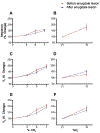Amygdala lesions reduce seizure-induced respiratory arrest in DBA/1 mice
- PMID: 31399338
- PMCID: PMC7474464
- DOI: 10.1016/j.yebeh.2019.07.041
Amygdala lesions reduce seizure-induced respiratory arrest in DBA/1 mice
Abstract
Sudden unexpected death in epilepsy (SUDEP) is the most common cause of death in patients with refractory epilepsy. Human studies and animal models suggest that respiratory arrest is the initiating event leading to death in many cases of SUDEP. It has previously been reported that the onset of apnea can coincide with the spread of seizures to the amygdala, and apnea can be reproduced by electrical stimulation of the amygdala. The aim of the current work was to determine if the amygdala is required for seizure-induced respiratory arrest (S-IRA) in a mouse model of SUDEP. Experiments were performed on DBA/1 mice that have audiogenic seizures with a high incidence of fatal postictal respiratory arrest. Electrolytic lesions of the amygdala significantly reduced the incidence of S-IRA without altering seizures, baseline breathing, or the hypercapnic ventilatory response. These results indicate that the amygdala is a critical node in a pathway to the lower brainstem that is needed for seizures to cause respiratory arrest. SIGNIFICANCE STATEMENT: Sudden unexpected death in epilepsy is the most common cause of mortality in patients with refractory epilepsy, and S-IRA is thought to be important in the pathophysiology in many cases. In a patient with epilepsy, the onset of apnea has been shown to coincide with spread of seizures to the amygdala, and in multiple patients, apnea was induced by stimulation of the amygdala. Here, we show that lesions of the amygdala reduced the incidence of S-IRA and death in a mouse model of SUDEP. These results provide evidence that the amygdala may be a critical node in the pathway by which seizures influence the brainstem respiratory network to cause apnea. This article is part of the Special Issue NEWroscience 2018.
Keywords: Amygdala; Respiration; SUDEP; Seizures.
Copyright © 2019 Elsevier Inc. All rights reserved.
Figures





References
-
- Thurman DJ, Hesdorffer DC, French JA. Sudden unexpected death in epilepsy: assessing the public health burden. Epilepsia 2014;55: 1479–85. - PubMed
-
- Nashef L Sudden unexpected death in epilepsy: terminology and definitions. Epilepsia 1997;38: S6–8. - PubMed
-
- Nelson DA, Ray CD. Respiratory arrest from seizure discharges in limbic system. Report of cases. Arch Neurol 1968;19: 199–207. - PubMed
-
- Hughlings-Jackson J On asphyxia in slight epileptic paroxysms: on the symptomatology of slight epileptic fits supposed to depend on discharge-lesions in the uncinate gyrus. Lancet 1899;1: 79.
-
- Ryvlin P, Nashef L, Lhatoo SD, Bateman LM, Bird J, Bleasel A, Boon P, Crespel A, Dworetzky BA, Hogenhaven H, Lerche H, Maillard L, Malter MP, Marchal C, Murthy JM, Nitsche M, Pataraia E, Rabben T, Rheims S, Sadzot B, Schulze-Bonhage A, Seyal M, So EL, Spitz M, Szucs A, Tan M, Tao JX, Tomson T. Incidence and mechanisms of cardiorespiratory arrests in epilepsy monitoring units (MORTEMUS): a retrospective study. Lancet Neurol 2013;12: 966–77. - PubMed
Publication types
MeSH terms
Grants and funding
LinkOut - more resources
Full Text Sources

